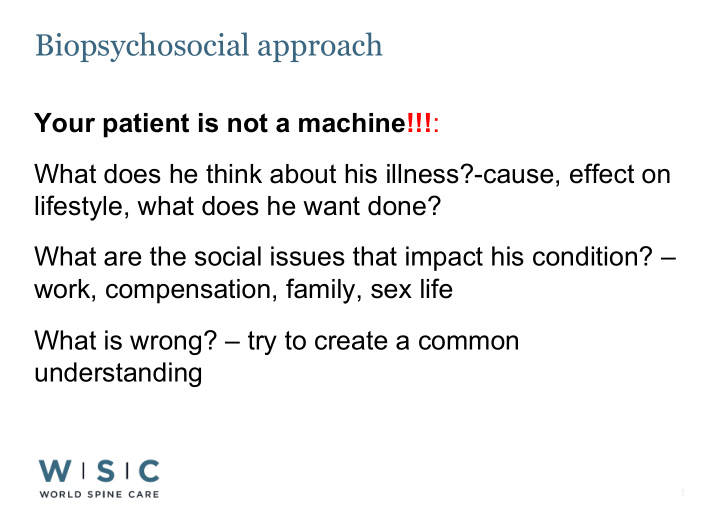



Biopsychosocial approach Your patient is not a machine!!! : What does he think about his illness?-cause, effect on lifestyle, what does he want done? What are the social issues that impact his condition? – work, compensation, family, sex life What is wrong? – try to create a common understanding 1 1
Patient Centeredness Treat pt. as unique individual-not a case of…. Welcome him Smile at him, exchange greetings, give him time to tell his story Ask him questions – let him ask questions Respect - his story, his body, his views/values Discuss/explain - diagnosis, investigations, treatment plans (as appropriate) Create rapport/friendship/a healing relationship 2 2
Low back pain Very common condition – 49% to 70% life prevalence, 12% to 30% point prevalence Health care costs – about $6,000 per year, per patient (2005) Compromises- mobility, productivity, attendance at work Can be excruciatingly painful NB – pancreatitis, nephrolithiasis, pyelonephritis, aortic aneurysm, endocarditis, impotence, work compensation 3 3
85% of low back pain has no major underlying disease (body pathology) - non specific LBP Rule out: compression fracture – 4% herniated disc (disc prolapse) – 4% ankylosing spondylitis - 0.3-4% symptomatic spinal stenosis – 3% cancer – 0.7% cauda equina syndrome – 0.04% spinal infections – 0.01% (may be different in Africa) 4 4
Physical Examination to determine A. Is there specific condition or pathology? B. Is there neurological involvement; progressing, severe? Based on findings: i. Non specific LBP – manage ii. Radiculopathy or spinal stenosis – refer iii. Specific cause e.g. TB or compression fracture - manage or refer as appropriate 5 5
Non specific LBP There is no significant underlying pathology Most patients will get well There is no need for investigations – X-rays, ultra sound, MRI, CT scans (drives unnecessary interventions and costs) (Investigate only – severe/progressive nerve problems, suspected pathology) 6 6
Pharmacological treatment – non specific LBP Most patients recover in 4 weeks – short course analgesics No bed rest - encourage patient to remain active Post 12 weeks and pain improvement minimal – reassess, give analgesics as required, multidisciplinary treatment programs, may refer for spine manipulation, consider psycho-social problems Paracetamol, NSAIDs, Opioids, muscle relaxants, (anti depressants, topical medications, heat) 7 7
Paracetamol Analgesic, antipyretic, no anti inflammatory properties Small or no effect as analgesic in non specific LBP Less effective than NSAIDS but better SE profile SE. Hepatotoxicity even at 4g/day (seems uncommon) - chronic hepatitis in Botswana - traditional medicine -chronic headache Pain is a social construct – is pain experienced similarly by Americans, Indians, Latinos, Africans??? 8 8
NSAIDS Analgesic and anti inflammatory properties – block cyclo-oxygenase (Cox) 1 and 2 (non selective), 2 (selective) Cox-1 protects stomach lining Suggested 1 st line treatment Selective and non selective equally effective In Bots consider costs: Cox 2 vs. non selective with proton pump inhibitor (ibuprofen +omeprazole) 9 9
NSAIDs SE profile Hepatotoxicity Gastric ulcers/ perforation Myocardial infarction CCF (elderly) Complicate BP treatment 10 10
Opioids For pain not controlled with paracetamol or NSAIDs Use for severe, disabling pain – who judges? How? For patients with high risk for side effects of NSAIDs treatment Starting patients on opioids should be considered carefully – abuse Substance abuse – personal or family history of substance abuse 11 11
Opioids • Side effects • Nausea • Constipation • Somnolence • Myclonus • Pruritis Abuse is a problem 12 12
Tramadol Affinity for opioid α receptors Not first line treatment Has similar effects as NSAIDS SE - potential for serotonin syndrome: agitation, confusion, fever, tachycardia, hypertension, rigidity, seizures, diarrhoea, sweating, shivering 13 13
Antidepressants Tricyclic anti depressants (TCAs) commonly used for chronic nsLBP Doubtful efficacy for pain relief Side effects: dry mouth, dizziness, arrhythmias, QRS prolongation 14 14
Skeletal Muscle Relaxants Have modest effect on pain relief Use in acute cases Combine with paracetamol or NSAIDs SE – sedation, hepatotoxicity (some) 15 15
Other Medications Anti-epileptics – insufficient evidence to recommend Systemic Corticosteroids – not recommended In Botswana – consider topical treatments; methyl salicylate, deep heat rub, and other skin preparations Ref. 16 16
17 17
19 19
20 20
21 21
22 22
23 23
24 24
25 25
26 26
27 27
28 28
29 29
30 30
31 31
Recommend
More recommend